
|   |

|   |
June 1, 2016  An entire month away from home, watching many varieties of dance, theatre and performance art forces me to spend more time and space than usual on a densely packed month of May. #TRIPLE THREAT NYC There are movies every dancer must watch, books that are a must read and plays/shows that should not be missed. Broadway continues to be the testing ground for so many great and inventive choreographers. The unique demands of creating for “THE GREAT WHITE WAY” (a euphemism for the glittering lights of Broadway in NYC) has spawned some of the most exciting choreography in American modern dance history. Remember Jerome Robbins’ stunning dance designs for WEST SIDE STORY in 1957 which was later adapted to film in 1961? The opening scene on the basketball court that morphs seamlessly into a dance “battle” between the two rival teams, SHARKS vs JETS? Ballet, modern dance and sports images fused effortlessly like a champion dribbling the creative ball. On a recent visit to New York, I watched AN AMERICAN IN PARIS. The Gershwin lyrics, “I Got Rhythm", "S Wonderful” had me foot tapping in my seat. It was exhilaration from the moment the curtain rose. The male lead was performed by Garen Scribner, a former dancer at NDT1, the fabulous Netherlands contemporary dance company. The TRIPLE WHAMMY of dancing, singing and acting that Broadway exemplifies, always leaves me awestruck. Imagine 8 shows a week. Non stop. For months without end. I wonder how most Indian dancers would handle even a 6 performance week long “run”. Think of what Akram Khan has done for the past 15 years! 3 shows a week without stop. That, according to his manager Farooq Chaudhry! Mind boggling! #MAGIC MANAGER- Farooq Chaudhry 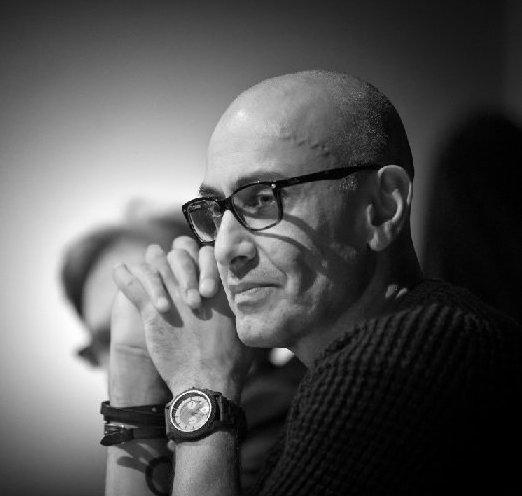 Farooq Chaudhry My conversation with Farooq Chaudhry was a personal highlight at the long awaited NAVADISHA 2016. Farooq spoke passionately about the first glimpse of watching Akram Khan dance in 1999. He sold his flat, with a young wife and a 9 month old baby, to finance the beginnings of what is now one of the most successful dance companies in Britain. Of the time that the superstar dancer “froze in fear” and how the recent debacle of flamenco dancer Israel Galvan’s accident during the TOROBAKA tour forced him to face disappointed and angry presenters. He was critical of the over submission of dancers to their gurus, urging them to rebel “like they do with their own parents”. That funding is being distributed like crumbs and that the brilliant classical dancers in Britain should be given “the entire loaf of bread” and not in bits and pieces. Now a corporate conglomerate with Akram Khan Dance Company and Khan/Chaudhry Productions, Farooq has become a King/Queen maker with a global network of presenters, agents and funders willing to do anything and accept any new artiste or production he envisions. India based dancers (Sanjukta Sinha and Aditi Mangaldas) are being actively mentored while the next “big thing” is a young Chinese performer who has caught his eye. Dance as a business? While we did not get numbers and figures from the animated conversation, it was enough to surmise that millions and millions were being offered to this unique creative partnership that Farooq described as an “open affair” with his genius dancer, a Bangladeshi Brit who has burst the confines of the South Asian tag to become Britain’s dance super hero! #ND16 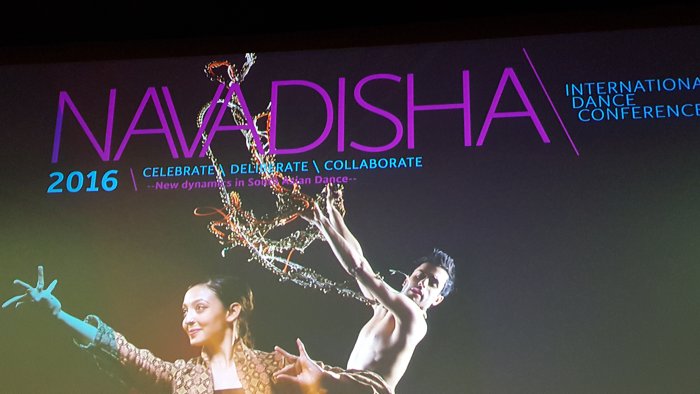 Official image for NAVADISHA 16 The NAVADISHA 16 Birmingham gathering of dancers, funders, presenters, mentors, educators and academics was a historic first for British South Asian Dance. (I have to confess a mild irritation at the term since I did not see anyone from another SOUTH ASIAN country in the delegate or performer roster). I was present at the 2000 NAVADISHA where, Conference Convenor Piali Ray (matriarch of SAMPAD ARTS-Midlands) described as ‘focused on Content. 2016 is focused on Context”. 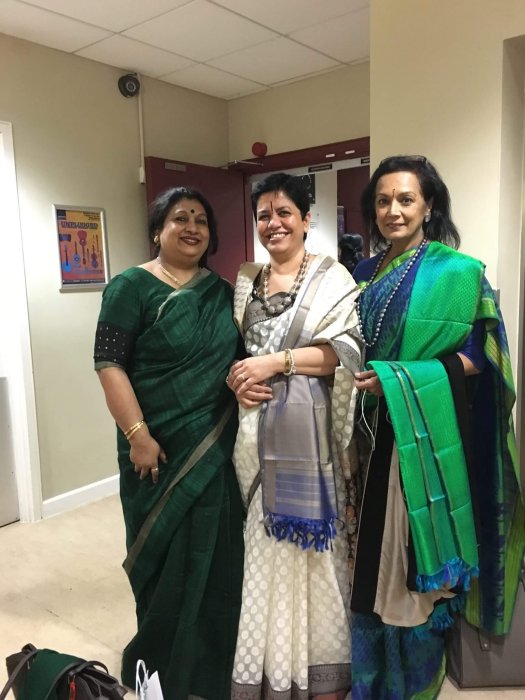 Piali Ray, Anita Srivastava, Chitra Sundaram What was the context? Producer Anita Srivastava (New Dimensions Arts), Co-Producer Piali Ray and Conference Moderator and Lead Consultant Chitra Sundaram articulated the intention of ND16 as a way “to stimulate, steer and secure the future of South Asian dance within the universe of British dance”. Placing the voices of artistes and organizers back to back was a strategic way of listening to points of view that differed wildly but were heard under the same roof! All the promise of “a dynamic space of excitement and enthusiasm” and high octane dancing was not fully delivered but ND16 was an ambitious reach to shift the discourse from the purely South Asian communities towards a mainstream engagement of how successful and vital the multi cultural policy of the UK Government has been over the past 30 years. As always, there were too many panels with too many people on them. Never enough time to discuss anything of significance. The inside joke was “which Navratan korma panel are you on?” Presentation quality differed wildly and time keeping was blurry. Arguments erupted and there were some public melt downs and impromptu standup comedy acts. Scholars and dancers gathered to network, greet, exchange notes and share information. 200 delegates from over 15 countries - all connected to Indian dance - assembled. A historic first in the UK! On the sessions I attended or chaired, there were several highlights. Bharatanatyam dancer turned science-movement investigator Subathra Subramaniam (formerly of ANGIKA DANCE) shared breathtaking images of her tours to the Arctic and her work using her learned technique with environmental issues. Professor and dance maker Hari Krishnan delivered a poignant talk on embracing his sexuality through choreography and staging choices. Singapore producer Aravinth Kumaraswamy was remarkably focused and coherent in his LOOK EAST policy of gathering South East Asian motifs for his vivid dance-theatre productions. On another panel, producer Anand Bhatt who manages the growing career of Akash Odedra, revealed the various kinds of collaborations in Europe for his dynamic star. The very presence of a producer for dancers was welcome. Someone who managed, negotiated, persuaded and secured programming and tours for the client. Even young Subhash Viman of Hip Hop fame has a manager! #APASWARA Disappointments were also in full flow. The afternoon showcases were a dismal parade of the shoddy, mediocre and banal. Propped by various funding and training agencies, the classical dance performances by the students were almost uniformly awful. Saving the day were Sonia Sabri (Kathak), Nina Rajarani (Bharatanatyam), Kamala Devam (breathtaking physicality from BN roots) and Shane Shambu (personal diary as dance theatre). The opening duet by the lovely Vidya Patel and Cameron Scott held much promise and Vidya is a dancer to watch. Another Gujarati girl - Seeta Patel - is already a British star but sounded frustrated (and confused) at the funding available for mentoring, teaching and outreach and not for classical dance touring. I wish Seeta was programmed in an evening performance. At least it would have shown us what this Mavin Khoo mentee was doing besides her short skirts and provocative appearance! I was appalled to learn of an outrageous sum of money being thrown towards teaching “confidence” to cancer survivors through dance. And no budget to tour Seeta or Nina in the UK? Conference organizers Sundaram, Ray and Srivastava can take pride and accept our collective bow for summoning so many individuals, ideas and officials in one place. It has never been attempted before and the very presence of senior arts managers heralded how important Indian dance has become for the UK arts policy. Naseem Khan can take more than the standing ovation she received for her seminal paper published 40 years ago ”THE ARTS BRITAIN IGNORES" that shifted cultural policy in the UK to the enormous benefit of South Asian organizations. The conference concluded with many unanswered questions. But the very coming together was a landmark. What happens to maintain the momentum remains to be seen. Once the reports are filed and papers forwarded, will the status quo remain? Will the various comments and open ended questions be followed through and acted upon? 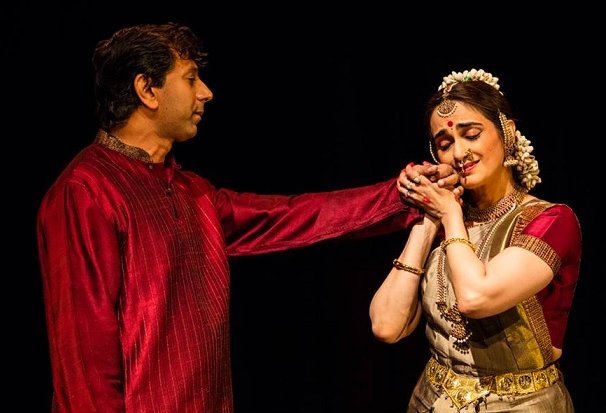 Yadavan - Nina Rajarani Photo: Vipul Sangoi #IDFB International Dance Festival Birmingham I have mentioned in earlier writings about the rise and rise of Kathak in the UK. The performances I saw every evening at the Birmingham dance festival (not associated with ND16 but planned during the same week) drove the point home. Akash Odedra (ECHOES) and Sanjukta Sinha (KIN) showed how aesthetic points of view have shifted dramatically from the poetic to the kinetic. Akash is a beautiful dancer who was able to rise above the sentimental and over romanticized material about “ghunghroos” to reinforce his talent and growing maturity. If Sanjukta Sinha could fix her makeup and costume, here is a woman on the fast track to super stardom. Unstoppable speed, zero facial abhinaya, breathless movement. All the mentors, producers, funders and support systems are in place for her. Within two weeks I had watched her in New Delhi and in Birmingham. While I may not be a fan, I know I am in the minority. From India, dancers Sujata Mohapatra and daughter Preetisha delivered a competent evening of Odissi dance, where the music soared above the predictable choreography. They were followed by a lacklustre show featuring Bharatanatyam couple Sheejith Nambiar and Parvathy Menon. I wish dancers would think about pacing their programming and not tacking on items that look, feel and sound the same. Sujatha had a pompous and cringe worthy voice over that described Indians as the “master race - the only one who could imagine the concept of ARDHANARISWARA!” Whew! She needs to get a reality check! The national award winning Nambiars need to recalibrate their presence and on stage chemistry that looked tired and dispirited. Mother-daughter / husband-wife combos open up so many possibilities of intimacy that are rarely explored. Like when we yearned for Nina Rajarani to go further with her tender duet (mentored by Chitra Visweswaran) with singer-husband Yadavan. Another evening presented the gorgeous contemporary soloist Hema Bharathi Palani from the Attakkalari stable. Supple, elegant and compelling, her solo TRIKONANGA was interesting in parts and stomach churning in others. (I turned away when saliva dripped on her hands). The choreography was a bit sloppy and over long but she is certainly someone to watch. British Hip Hop dancer Subhash Viman was a playful, quirky presence with his MORPHED. I had watched the work being created in Bangalore 2 years ago with choreographer Veena Basavarajaiah and remarked on his double jointed body. #ND 16 KEYNOTES - ON AND OFF KEY Can living in beautiful and medieval Malta - the film backdrop for GLADIATOR and TROY - alter one’s reality? Perhaps that is what happened to Mavin Khoo, currently Artistic Director at the Dance Department at Malta University. His conference keynote wove an unfamiliar mythology about Guru Adyar Lakshman in terms that were totally unrecognizable to me - his first independent student. Instead of talking about his “here and now,” his multi racial roots in Malaysia with an Indian mother, his early years with gurus Ramli Ibrahim / Lakshman Sir, and his fascinating journey through highs and lows in the UK, Mavin decided to become a Mylapore sabha dancer, speaking about Chennai’s Krishna Gana Sabha, Lakshman Sir’s last minute improvisational programming while Mavin was already on stage, switching ragas midstream - all of which portrayed my guru as mercurial, moody and unpredictable. Accompanied to the “oohs” and “aahs” of his adoring fans in the audience, his rambling keynote was unimpressive for those of us not in the thrall of his self induced aura. Mavin Khoo’s genius as a performer, his contribution to the speed and agility to modern day Bharatanatyam and his intelligent distillation of ballet, Bharatanatyam, Odissi and contemporary dance could have been much better showcased if he had snapped back to the present. The one valid point he made was that the dancing body needs to be present in the rehearsal studio every single day. I remember the furor that erupted in 2000 when he described Chennai Bharatanatyam dancers as “housewives” and Priyadarsini Govind rising in protest at his precocious statements. In direct contrast to Mavin were Akram Khan and Shobana Jeyasingh. Both artistes were given keynote slots on successive days and both made an impact - though in vivid contrast. Opening on Day One was Akram who started on a dire note by quoting American war veteran Roy Scranton about the end of civilization. He pleaded for continuous training in classical dance forms because it inhabited the spaces between spiritual and sacred - between man and God. Some Akram quotes: "What the F..CK is South Asian Dance?” “The era of taking risks is already dead.” “My body is my voice-disembodied, discontinuous, disconnected.” "Do we need South Asian dance?” “Where are the South Asian philanthropists?" 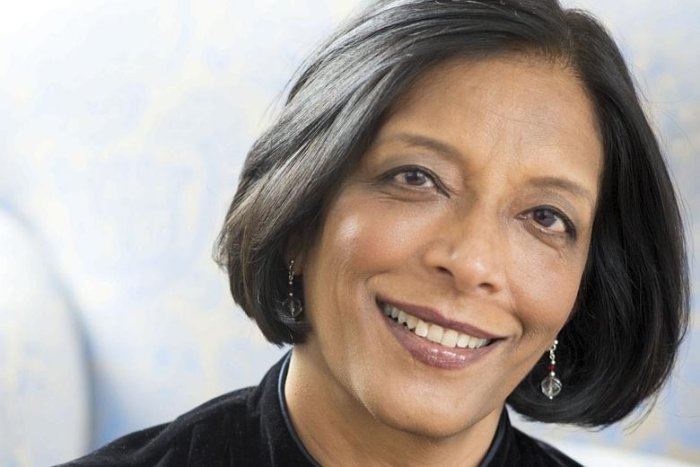 Shobana Jeyasingh Photo: JB Masclet On Day Two, the irreplaceable Shobana Jeyasingh, Britain’s first superstar choreographer of modern Indian dance addressed a packed hall. Without being political Shobana always manages to touch upon all the elements that affect the history of her form - Bharatanatyam. Drawing on her early life, the cerebral dance maker has quietly fought a war against any kind of imposition by Imperialist taste pundits. Conference Moderator Chitra Sundaram recalled the 1982 Festival of India report which described the Kathakali dancer as wearing a head dress of “toilet brushes” and Kuchipudi artiste C.R. Acharyalu as a “eunuch.” It was Shobana who wrote in strong protest against such stilted and outrageous comments. If only someone could have written strongly in 2013 when New York Times described Koodiyattam performer Kapila Venu’s head dress as like “a wedding cake!” How little has changed! Shobana’s brilliant thoughts were so laden with quotable quotes that I bring you a selection. “All dance work reflects the politics and values of the creator.” “C for contemporary means that I am on the side of change. An excursion without a fixed destination.” "Bharatanatyam is over invested in dance history and politics.” “South Asian dancers are mostly like noble hobbyists, not fully invested in their art." “I work with the cultural elasticity of life in the diaspora.” “The roots in my garden are like a creative mind - twisting and turning, searching for common sustenance in common soil.” "Good technique is intelligent dancing.” “A choreographer’s imagination is like a personal signature that needs the endorsement of the dancer.” 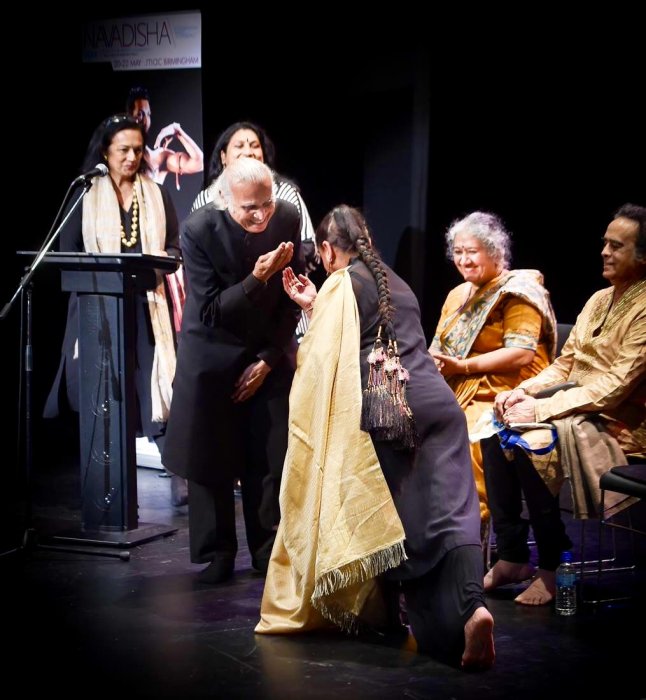 Nahid Siddiqui acknowledging the award bestowed upon her by Dr Sunil Kothari Photo: Simon Richardson Many moving moments included the honoring of senior gurus and dance catalysts. Pushkala Gopal, Pratap Pawar, Nahid Siddiqui and Naseem Khan who were greeted with standing ovations for their sustained pioneering work in the UK. Why have I spent so much time and space on the NAVADISHA 16 conference? It is because, unlike those that occur in India, we got a chance to meet with theatre owners, funders, teachers, analysts, producers and agencies that revealed the depth and breadth of how important dance and the performing arts have become to the social fabric of Britain. It also revealed that the Indian DNA is still feudal and that the first rung “gatekeepers” are amongst us and not always “the other” as is the common perception. Who is being chosen to perform? Who is being favored? Who is being selectively funded? Is the funding pot of gold more important than the creative idea? Glaringly absent were the dance writers. For the second largest community in Birmingham, this South Asian conference should have received more mainstream press. In the USA, there are at least 5 high level dancers and musicians who are seen regularly at India's top tier festivals. Is it because the cushy funding systems in the UK have made dancers so inward looking that no outside engagement or critical evaluation is necessary? I was the biggest and loudest advocate of British accented Bharatanatyam and Kathak since I attended Mira Kaushik / AKADEMI's outdoor spectacle COMING OF AGE in 2000. Now, 16 years later, I modify my stance with a more nuanced appreciation for the classical and contemporary dance makers in India. With very little or nothing so much is happening. Quietly. Without fuss and fanfare. Has the rhetoric in British South Asian dance outpaced the actual reform on the ground? Can there be a real shift in the discourse with newer and younger arts managers stepping up? For centuries, the UK has been at the forefront of so many innovations and new ideas. In the arts, especially for South Asian forms, the UK has been the model against which many of us have either moulded or attempted to shape our training and attitude towards a global perspective of music and dance. Britain has been the beacon for arts administration, networking, infrastructure and support. Canada and Australia, former colonies, have replicated much of the innovations. Midway between India and the USA, its geographic location alone makes it the thoroughfare of all ideas and energies. No matter where I go, the Indian mindset seems to persist. What is the use of all this funding if not even 5 dancers every year are willing to submit to the daily rigour of a life in dance? Each year almost 1000 students graduate from Contemporary dance courses and universities in the UK. The Indian/South Asian story is vastly different. Dance is only serious hobby until money/job/real life calls! No wonder Shobana Jeyasingh has shifted her work on contemporary dancers with the Indian presence being limited to one or two! Before arriving in the UK, I was in New Jersey where, one evening, I found myself in the midst of 100 educated affluent Tam Brams (Tamilian Brahmins for those who are unfamiliar with the term!). The occasion was a Bhajan gathering. More than half the group had a child in dance, vocal music and instrument class. They were all serious about the weekly sessions - preparing for the ‘arangetram’. Simultaneously, preparations were on for college admissions into mostly the top IVY LEAGUE institutions. Some were also part of their college Indian dance groups like NATYA at Rutgers University. These ensembles compete with other colleges in the USA and the rehearsals are intense for these events. However, not a single parent or dancing daughter expressed interest in attending Mythili Prakash’s performance in New York in April. Most had not even HEARD of the DANCING FOR THE GODS event. Or the upcoming ERASING BORDERS or DRIVE EAST. Attending Bharatanatyam class is one thing but attending professional shows to improve their knowledge is not. Ask them to spend 400 dollar tickets to take their screaming kids to a Justin Bieber concert? No problem! How are we going to deal with these “ig-noble hobbyists?” Will it EVER change? 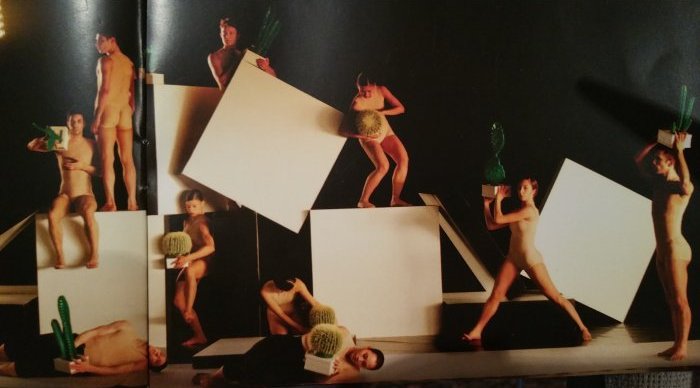 CACTI by NDT2 at SADDLERS WELLS, London I share these thoughts amidst a dense calendar of watching more than 15 performances in May. Ballet, contemporary dance, rehearsals, dance films and videos. A gorgeous new theatre space in Brooklyn (St Ann’s Warehouse) where A STREETCAR NAMED DESIRE was staged in an unusual revolving stage, BALLET BC in Birmingham - smack in the middle of the ND16 event, and of course NDT2 at London Sadlers Wells. It was dance 24/7 and in 360 degree intensity. It was a startling wake up call to all those who care about Indian dance that the very nature of training, teaching and education has to change. Rebellion must be considered. Serious questions must be asked and a new order is called for. Nina Rajarani’s question about WHY classical Indian dance training has to live up to a contemporary choreographer’s punishing physical standards was very valid. Classical dancers are not just “waving their hands about” as one conference promoter suggested to angry protests and devastating tweets. However, the urban eye demands thrills and sedate stillness does not bring bums on seats. As one venue manager declared, “Create an Indian RIVERDANCE with classical dancers and the seats will be sold!” ND16 was more than a conference. It was the interstices that were as revealing about the state of South Asian dance in the various countries and communities they were situated in. That Indian dance was so compelling and powerful an entity to suck us all into its spell. Comparing FIT BIT daily progress records with Ananda Shankar Jayant, sharing a bottle of Prosecco with Hari Krishnan, queuing up for the daily soup specials at the swanky MAC cafeteria, admiring individual fashion statements, sharing a taxi ride with Akram where he spilled stories of his two kids and his growing guilt of being an absentee father. These moments make conferences come alive in vivid technicolour. 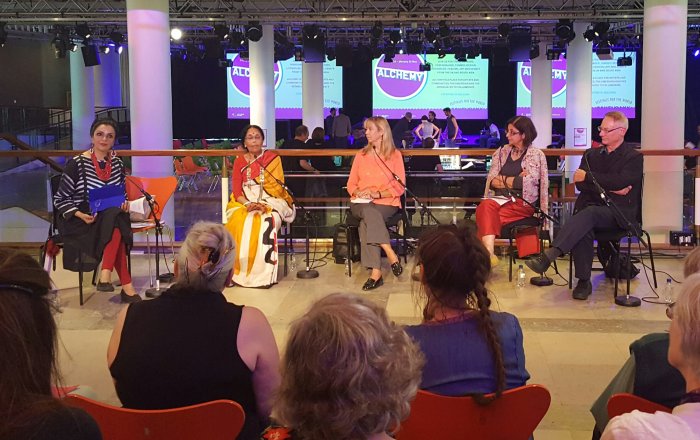 ALCHEMY MASTERS PANEL at South Bank, London Chairing a panel discussion about maturity and changing perceptions in Indian dance. With Bisakha Sarkar, Jane Hackett, Sanjeevini Dutta and Chris Bannerman. Royal Festival Hall, London My final day was spent at London’s South Bank at the fun filled ALCHEMY. Now in its 6th year, dancer Gauri Sharma Tripathi invited me to chair the panel on AGEING DANCERS (ouch!!) and the ensuing challenges in a world fueled by youth and speed. As Chitra Sundaram commented in a private discussion, “When will mature dancers be programmed as normal and not as an oddity?” The discussion was energetic with ballet dancer Chris Bannerman and Arts Administrator Jane Hackett contributing vital points of view. PULSE editor Sanjeevini Dutta and dance educator Bishaka Sarkar also made valuable comments. To hold up Indian dance as an example of being able to “dance forever” is also not accurate. We have examples of Indian dancers who should have retired but will need to be shot to get off the stage!!! ALCHEMY’s outdoor food festival may have been the most accurate representation of the SOUTH ASIAN tag that is used in the UK without much thought. Stalls from Sri Lanka, Afghanistan, Bangladesh, Pakistan, Anglo Indian cuisine, artisan chocolateries, Ethiopian coffee - the atmosphere was infectious and jam packed. I returned home just three days ago to post elections /same government. Same AMMA in power. Same promises. Same chaos on city streets. Water shortage. Power cuts. Blazing heat. Garish arangetram invites clogging my mail box. Ugly dance images assaulting my Facebook timeline. Self congratulatory messages on WhatsApp. SIGH! My smiles were reserved for my two children and a mango tree in my garden laden with fruit. Perhaps the promise of the ripe plucking and the very sight of the familiar was enough to fill me with gratitude. That, in the midst of so much hyperbole, corruption and scandal, the world of dance in India continues to be starved of camaraderie, support and attention. And still, we create magic. Great art. Stellar moments where the heart can sing. Anita R Ratnam Chennai/ Mumbai/ New Delhi/ Stockholm/ Oslo PS: Thank you all for the generous and overwhelming outpouring of love and goodwill on my birthday. In Birmingham amidst dance and dance makers, it was laughter, champagne and reminiscences. Thanks to social media, dance lovers took a moment to send me wishes. I am deeply touched. Twitter: @aratnam Facebook: Anita R Ratnam Instagram: @anitaratnam Blog: THE A LIST / anita-ratnam.blogspot.in Comments Anita, so well written..Your editorials are something that I always look forward to every month...and the best part of the whole thing is you call a spade a spade because you have no axe to grind....There is a lot to learn from you..Be there always..Stay Blessed.. - Roja Kannan (June 8, 2016) Post your comments |